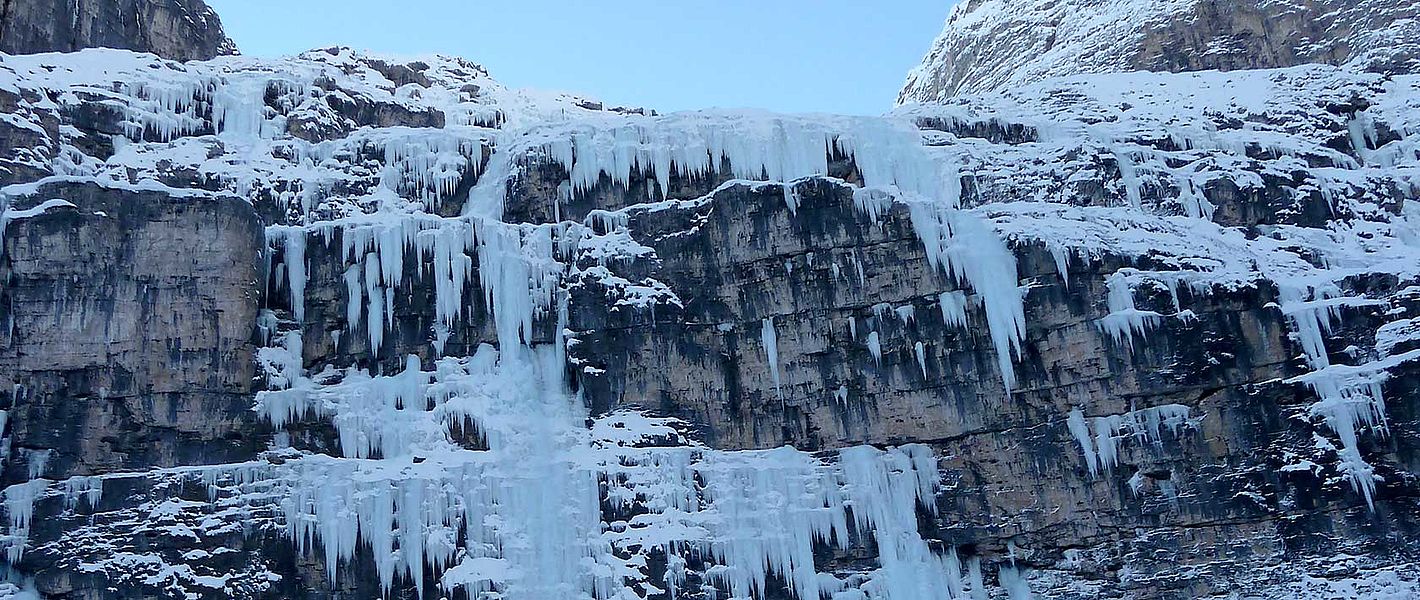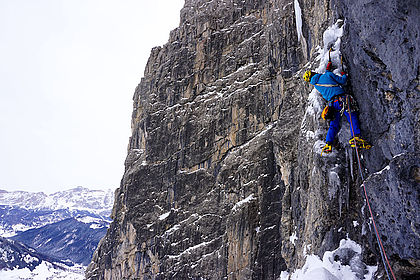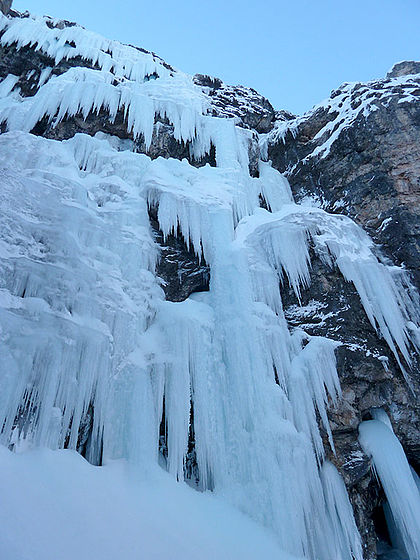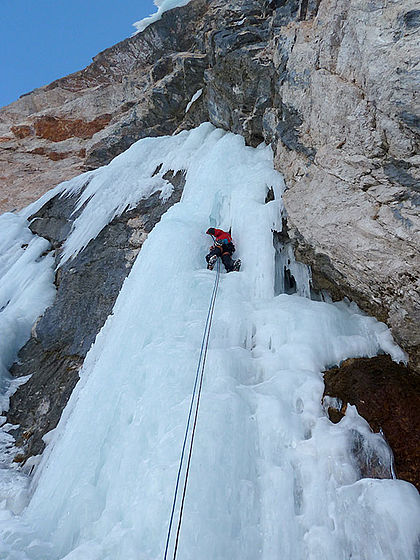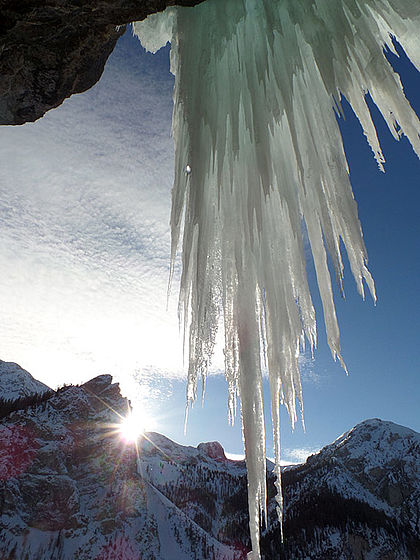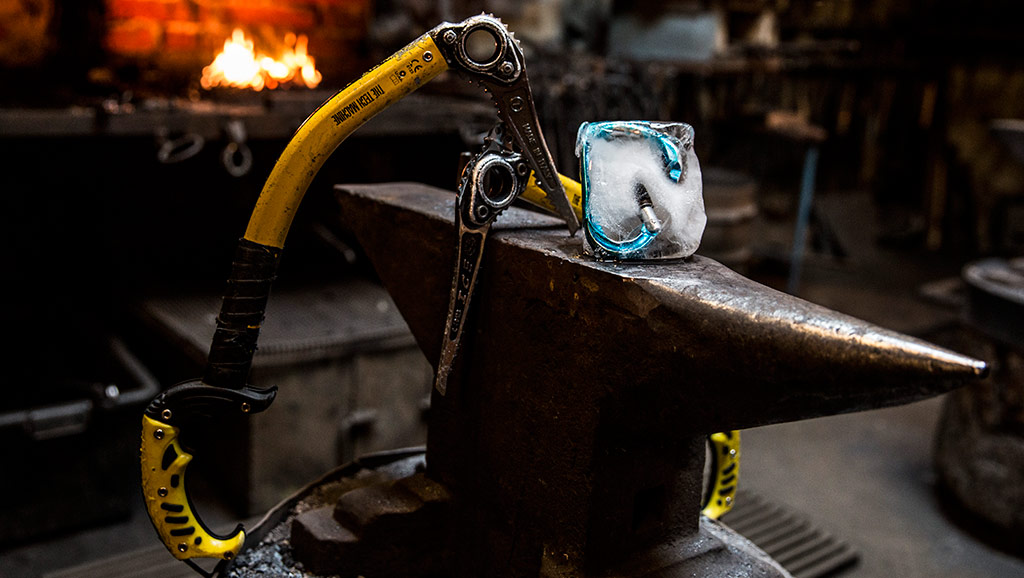In the Dolomites you climb on the foot of large, vertical walls, often also in drains and chimneys, which finally lead to bands and high plateaus with enchanting views. The Dolomites are a huge region, which could be subdivided. For example, a weekly programme alone in Reintal “valley”, Corvara, , Corvara or Sottoguda would be a good idea. However, should you not be focused on one specific destination, many areas can be reached quite fast from the Pustertal valley. In any case a must for every ice climber!
ice climbing highlights in the South Tyrolean Dolomites & Ahrntal valley
- Travenanzes (icefall called Kanadischer Traum - WI5, 300m)
- Pragsertal valley (icefall called Goasborscht - M5 WI5, 200m)
- Sottoguda (icefall called Spada nella roccia, WI5, 60m)
- Langental valley (icefall called Mission Impossible, WI5+, 250m)
- Corvara (icefall called Schwert des Damokles, WI5, 180m)
- Reintal valley (icefall called Ursprung, WI4, 200m, Crazy Diamond M8 WI6, 200m)
schedule
As our travel time is not too long, we offer one-day tours in this region, though the travel expenses will be charged additionally. If a multi-day programme is desired, the accommodation of the mountain guide must also be provided. Call us or write an e-mail, we will be happy to advise you and put together a suitable programme!
location / how to get to destination
The icefalls of the Dolomites and the Reintal valley are mainly in South Tyrol, as well as in Trentino and Veneto. The most central place to be as flexible as possible is for sure Bruneck. From there you can reach the Reintal valley, Corvara and the Pragsertal valley in a bit more than half an hour.
sleeping / food
Accommodation and food are not included in the price. In this region, accommodation is available in every price category. We recommend to book the accommodation early enough as especially in the high season (Christmas, February - March), places are quickly fully booked.
Here are some addresses:
Bruneck
Rein in Taufers
Corvara
apparel and equipment list
Technical material is included in the price.
Since we do not climb constantly, there can be "standing times" in cold temperatures, so make sure to bring along enough warm clothes - one cools down quite quickly!
We recommend you bring light clothing of varying thickness to achieve an "onion system" for greater comfort. Cotton is not suitable as it quickly becomes cold upon getting wet. Skiing apparel, however, works well. Our recommendation: warm merino underwear and a fast warming down jacket.
We recommend:
- long underwear (bottom and top), synthetic, merino or wool
- warm pants (lined or fleece)
- warm fleece or long sleeve shirt (not cotton)
- lined jacket or vest, preferably down jacket
- waterproof jacket with hood (Gore-Tex or nylon)
- waterproof pants (Gore-Tex or nylon)
- socks (merino or ski socks)
- woolen cap or lined cap that protects your ears and fits under a helmet
- waterproof climbing gloves (2 pairs)
- solid mountain boots (in exceptional cases ski boots are also possible)
- gaiters if necessary
- Buff (neck protection)
- a minimum 25 litre backpack (space for clothing, snacks, drinks, climbing equipment)
- sun protection (glasses and cream)
- thermos or water bottle (already full!!!!)
- camera
- personal medicine
If you want to take your own technical material with you: (otherwise rental equipment included in the price)
- crampons: must fit the shoes and be easily adjustable, with vertical front teeth
- climbing harness: always with adjustable leg loops
- climbing helmet
- ice axe: steep ice axe
- screw carabines
- backup device: reverso, ATC or similar
details & insurance
NOT INCLUDED IN THE PRICE
- travel to destination
- drive to the respective ice climbing area or icefall
- accommodation costs before, during or after the courses
- travel expenses for the mountain guide
- accommodation for the mountain guide (for tours of 2 days or more)
- travel and cancellation insurance
- personal climbing apparel
- tip
